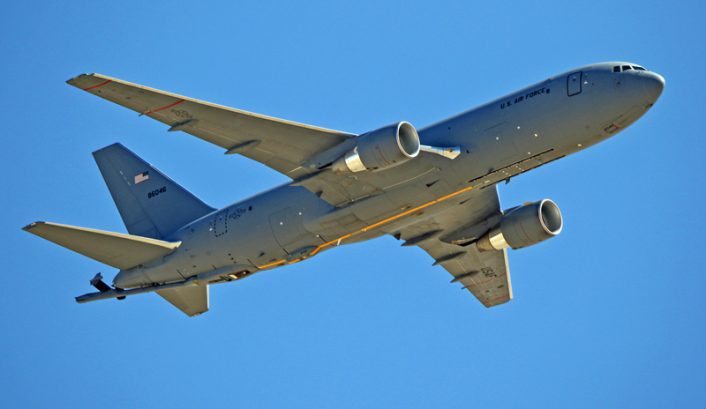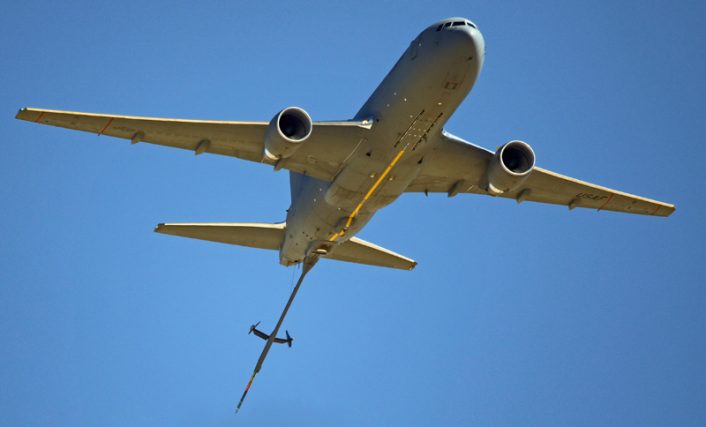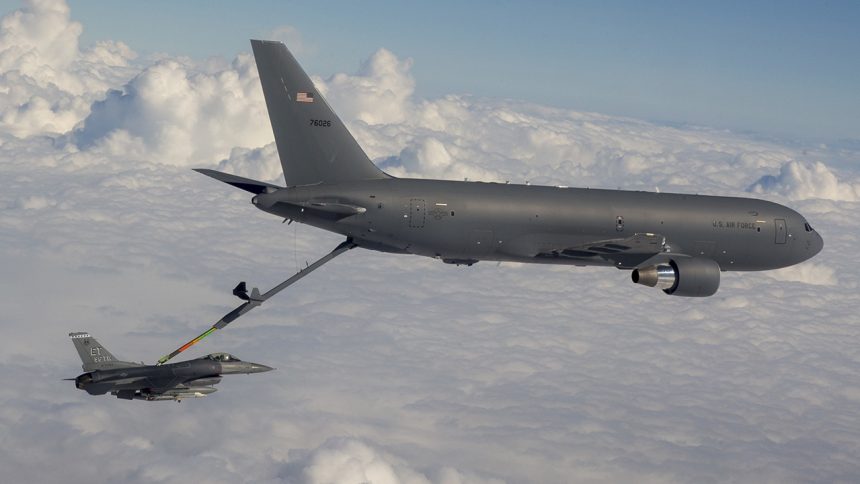Airband listeners heard an F-16 pilot report ‘a chunk taken out of its spine due to a too close breakaway incident’ during refueling operations with a KC-46.
On June 27, 2024 an inflight refueling incident occurred between a new U.S. Air Force KC-46 Pegasus aerial tanker and an F-16 off the coast of Netherlands.
The incident was first reported by our friend @EHEH_Spotter who posted parts of the radio comms listened on the boomfreq (the frequency used by the boomoperator to instruct receivers); the F-16s’ air-to-air and OPS frequencies.
The audio is pretty clear: an F-16C flying with radio callsign “WARHAWK 3” sustained “door damage” and also radioed that there was, “a chunk taken out of its spine due to a close breakaway incident”. Further radio traffic said that “KANZA 91”, the callsign being used by the KC-46, was, “damaged and unable to refuel”. Another aircraft was requested to conduct a visual inspection of the KC-46 to see if, “there were cables flying from the back of the aircraft”
🇺🇸USAF Boeing KC-46A Pegasus 15-46009 as flight #KANZA91
🇺🇸USAF SP F16A as flight #WARHAWK3 (2 ship with WARHAWK2)
Issue during AAR : to close break away incident -> damage #WARHAWK3 & boom #KANZA91 #NLspot #USAF pic.twitter.com/0kTRQrHnhP
— ”The Lazy 🌴 Garden 🌴” Eindhoven Spotter 🇳🇱 (@EHEH_Spotter) June 27, 2024
Following the mishap, WARHAWK1 continued with its mission whereas WARHAWK3 (with the problem at the refuel door) and WARHAWK2 returned to Spangdahlem Air Base, Germany.
KANZA91 (KC-46) had a boom damage while they were air refueling Warhawk flt (F-16)
Warhawk tac A/A: 281.050MHz
Boom radio: 363.325MHz
Warhawk Ops: 299.850MHz https://t.co/9FaLkw60Nz pic.twitter.com/6t0EB5rB9b
— Pity man (@PityPityman5) June 28, 2024
The story is now receiving widespread notice as it has been corroborated by Air & Space Forces magazine report by Chris Gordon published on June 28, 2024.
Gordon wrote that, “The aircraft involved were an F-16 was assigned to the 52nd Fighter Wing at Spangdahlem Air Base, Germany, and a KC-46A from the 931st Air Refueling Wing, an Air Force Reserve unit based at McConnell Air Force Base, Kan., that is forward deployed to Europe, a spokesperson for the 52nd Fighter Wing told Air & Space Forces Magazine.”
RCH269
United States Air Force
Boeing KC-46A Pegasus
15-46009🇺🇸#AE574F
Back towards the 🇺🇸 as mentioned by @EHEH_Spotter #P950 #KANZA91 #RCH269 #USAF #planespotting #avgeek #aviation #Boeing #F16 #NLspot https://t.co/1jMZ7XQPrZ pic.twitter.com/ezxMB4ykeo
— Danny Lemckert 🇳🇱✈ (@DLNetherlands) June 29, 2024
A standard acknowledgement of the incident being “under investigation” was released by the 52nd fighter wing, the unit the incident F-16 belongs to, but the Air Force did not specify damage to either aircraft.
Flight tracking data cited in Chris Gordon’s report showed the KC-46 circling near Spangdahlem Air Base in Germany at an altitude of approximately 8,000-feet for nearly an hour before the aircraft landed at the base four hours after its training mission began.
Gordon continues his report by saying the two aircraft were part of a joint exercise with the Dutch Air Force. A 52nd Fighter Wing spokesperson cited by Gordon said, “The aircraft incident did not affect Exercise Turbo Weasel, an incredible training opportunity between the United States and Dutch Air Forces, which occurred during the week of 24-28 June”.
While the circumstances surrounding this incident remain the focus of official investigation, the KC-46 Pegasus program has broadly taken a beating in media reports about the development and deployment of the new generation tanker and transport aircraft. As reported by Gordon, the KC-46, manufactured by Boeing, has faced significant issues with its refueling system. The Air Force and Boeing are working to address several Category I deficiencies, including a “stiff” boom and problems with the Remote Vision System (RVS), which suffers from visibility problems in certain conditions like direct sunlight. These issues can impair the boom operator’s depth perception, increasing the risk of accidental collisions during refueling.
Still, AAR mishaps may happen (and they do occur every now and then) and they are not necessarily caused by a failure of the tanker.

A “risky” operation
Air-to-air refueling always involves significant risks and has led to notable incidents in the past due to a variety of factors, including mechanical failures, human error, and adverse weather conditions.
A quite famous incident dates back to Oct. 15, 1959, when a mid-air collision occurred between a B-52F and a KC-135A during an aerial refueling mission over Hardinsburg, Kentucky. The incident was part of the STEEL TRAP mission by the 4228th Strategic Wing. The collision resulted in a massive fireball and the loss of several crew members, although some managed to eject safely. Wreckage from the aircraft was scattered over a wide area, but fortunately, no ground casualties occurred.
Another one occurred on Jan. 17, 1966, when a B-52G collided with a KC-135 Stratotanker during aerial refueling above the Mediterranean Sea, near the coast of Spain. Both aircraft exploded in mid air killing seven aircrew members. This incident is famous as the Stratofortress carried four B28 thermonuclear weapons, three of those hit the land near Palomares: two of them caused a non-nuclear TNT explosion, but in their impact with the land they released some radioactive plutonium. The fourth bomb was lost into the Mediterranean and it was found unexploded at a depth of 2,550 feet on Mar. 17; it was recovered only on Apr. 7, by some U.S. Navy ships.
One notable incident between aircraft using the “probe and drogue” system occurred in October 2018, when a KC-130J Hercules collided with an F/A-18D Hornet off the coast of Japan. The collision resulted in the death of six U.S. Marines. The investigation revealed that spatial disorientation played a key role, exacerbated by the challenging nighttime conditions and the complexity of the refueling operation.
Another famous incident occurred on Sept. 29, 2020, when a U.S. Marine Corps F-35B, callsign VOLT 93, with the Marine Fighter Attack Squadron (VMFA) 121 “Green Knights”, and a KC-130J, flying as RAIDER 50, belonging to the Marine Aerial Refueler Transport Squadron (VMGR) 352 “Raiders” made contact during AAR operations. The F-35B pilot successfully ejected from the Lightning II (and the video of the jet crashing into the desert near Coachella Valley, California, made the rounds), while the KC-130J pilot managed to perform a safe crash landing on a field near Thermal Airport, California. The KC-130J pilot managed to carry out a successful crash landing despite extensive damage to the engines on the right-wing and the refueling pod, saving the life of all the crew members who assisted him during the emergency. For his life saving action, that pilot, Pittsburgh, Pennsylvania native Capt. Michael Wolff, received the Distinguished Flying Cross from Maj. Gen. Bradford J. Gering, 3rd MAW commanding general, the U.S. Marine Corps said in a public statement.
Needless to say, these accidents occur also to foreign air arms: for instance, on Jul. 27, 2012, an Israeli F-16I was undertaking a routine training mission when the flying boom of the tanker struck its canopy damaging the F-16’s HUD (Head Up Display) and the boom, forcing the pilot to perform an emergency landing at Ovda Air Base near Eilat.
These accidents often occur due to the complex and delicate nature of AAR operations. Mechanical failures, such as malfunctioning booms or probes, can lead to catastrophic outcomes if not addressed promptly. Human error is another significant factor, as pilots and boom operators must perform precise maneuvers, sometimes under stressful conditions like poor visibility or turbulence. Additionally, the physical stresses on the aircraft and the refueling hardware can cause wear and tear, leading to unexpected failures.

“I’m not sure I’d characterize Air-to-Air refueling (AAR) itself as risky. Rather, I always thought of it as requiring strict attention to the slight but significant changes taking place as you approach, engage, and then maintain position on the drogue,” former USMC F-4 Phantom II pilot, combat veteran, author and Stanford graduate John Trotti told us about midair refueling using the probe and drogue system employed by U.S. Marine aircraft (that is different from the “flying boom” used by the U.S. Air Force).









